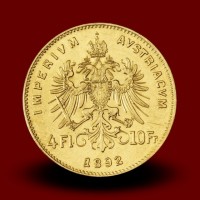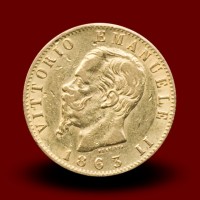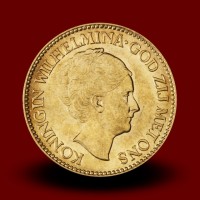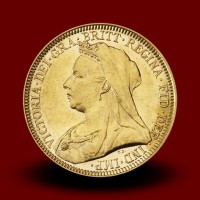Investment Gold coins, minted after year 1800 There are 21 products.
-
3,23 g, Gold coin / 4 Florin / restrike
The 4 Florin gold coins were designed as trade coinage between 1870 and 1892. The Florin gold coins were minted in two denominations: the 4 Florin gold coins with a face value of 10 Francs and the 8 Florin gold coins with the corresponding value of 20 Francs. Nowadays, the Austria Mint is still producing the 4 Florin 10 Francs gold coins as gold bullion...
-
6,46 g, Gold coin / 8 Florin / restrike
Originally a silver-based currency dating from the 19th century, the Gulden was issued to circulate freely within the Latin Monetary Union, comprising France, Belgium, Italy and Switzerland. Austrian Mint, however, struck its very own impressive 4 and 8 gulden coins in gold up until 1892.
-
3,39 g, Gold coin / 10 Crown / restrike
Dating back to the currency reform of 1892, the Crown became the first gold currency in history when 10 and 20 crown coins were issued in place of the Gulden. The stately and much larger 100 crown coin was issued on Emperor Franz Joseph’s diamond jubilee in 1908.
-
6,77 g, Gold coin / 20 Crown / restrike
Dating back to the currency reform of 1892, the Crown became the first gold currency in history when 10 and 20 crown coins were issued in place of the Gulden. The stately and much larger 100 crown coin was issued on Emperor Franz Joseph’s diamond jubilee in 1908.
-
33,90 g, Gold coin / 100 Crown / restrike
Dating back to the currency reform of 1892, the Crown became the first gold currency in history when 10 and 20 crown coins were issued in place of the Gulden. The stately and much larger 100 crown coin was issued on Emperor Franz Joseph’s diamond jubilee in 1908.
-
6,46 g, Gold coin / 20 Bfrs Leopold II
The 20 Francs gold coin is from Belgium. Featuring the portrait of Leopold II issued 1870 - 1882 (the earlier version was issued 1867 - 1870 and differs only slightly), the reverse has the Belgian coast of arms and the inscription L'UNION FAIT LA FORCE. This was the motto used by Belgium after it's revolution of 1830.
-
6,46 g, Gold coin / 20 Frfs Napoleon III
1863 20 French Francs gold coin. This version has the Laureate head portrait of Napoleon III and the reverse has the value and year with the imperial coat of arms. The text reads NAPOLEON III EMPEREUR and EMPIRE FRANCAIS. The "A" mint mark indicates that the coin was minted in Paris.
-
6,46 g, Gold coin / 20 Frfs Angel
French Angels, and all French 20 Francs, see consistent demand from a variety of gold buyers thanks to their attractive combination of characteristics. Last struck in 1898, the supply of Gold French Angels is naturally fixed and limited in contrast to all modern bullion coins that are struck in large numbers annually which adds extra profit-potential.
-
6,46 g, Gold coin / 20 Frfs Marianne
This 20 Francs Marianne Rooster gold coin is beautifully designed, being one great choice for collectors and investors. Collectors will see in it the delicate and rich history of France, a coin belonging to a long gone era, being also an appropriate coin for those that are fascinated by the French culture.
-
6,46 g, Gold coin / 20 Lire Vittorio Emanuele II
This 20 Lira gold coin of Kingdom of Italy represents one of the oldest royal families in the world, the House of Savoy, known since 1003. If you would like to own a piece of 19th century Italy, a period marked by remarkable cultural changes and fascinating shifts in power, then Tavex is pleased to present a truly intriguing specimen, the 20 lira Vittorio...
-
6,46 g, Gold coin / 20 Lire Umberto I
The Italian 20 Lire Umberto I gold coin is a wonderful addition to any collection and unique example of 19th century European gold coinage. The Lira was the name chosen for the new coinage of the kingdom starting in 1861. Issued 1879 - 1897, this 20 Lire (Lira) gold coin features Umberto I Re D'Italia and the italian coat of arms.
-
6,46 g, Gold coin / 20 Sfrs Vreneli
Swiss Vreneli gold coins are popular with European gold investors, along with some of the other European gold coins. These coins are no longer produced, and therefore all coins are in circulated condition. Though primarily minted in Bern, some were also minted in Paris and Strasbourg.
-
6,72 g, Gold coin / 10 HFL Wilhelmina, William III
10 Dutch guilders (of 1875-1933) is a series of gold coins with a rich history. Starting from the XVIIth century, they served as a symbol of stability and reliability, which makes them an excellent addition to any numismatic collection.
-
7,96 g, Gold coin / 20 Mark
The 20 Mark gold coins were issued in the German Empire between 1871 and 1914. The most common today are the 20 Mark gold coins with the Prussian emperors Wilhelm I, Friedrich and especially Wilhelm II.
-
7,98 g, Gold coin / 1 Pfd Victoria
The sovereign is a British gold coin with a nominal value of one pound sterling and contains 0.2354 troy oz of pure gold. Struck since 1817, it was originally a circulating coin that was accepted in Britain and elsewhere in the world. Their real value is based upon their gold weight and collectibility, or Numismatic value, which is worth considerably more.
-
7,98 g, Gold coin / 1 Pfd Edward VII
The sovereign is a British gold coin with a nominal value of one pound sterling and contains 0.2354 troy oz of pure gold. Struck since 1817, it was originally a circulating coin that was accepted in Britain and elsewhere in the world. Their real value is based upon their gold weight and collectibility, or Numismatic value, which is worth considerably more.
-
7,98 g, Gold coin / 1 Pfd Georg V
The sovereign is a British gold coin with a nominal value of one pound sterling and contains 0.2354 troy oz of pure gold. Struck since 1817, it was originally a circulating coin that was accepted in Britain and elsewhere in the world. Their real value is based upon their gold weight and collectibility, or Numismatic value, which is worth considerably more.
-
7,98 g, Gold coin / 1 Pfd Elizabeth II
The sovereign is a British gold coin with a nominal value of one pound sterling and contains 0.2354 troy oz of pure gold. Struck since 1817, it was originally a circulating coin that was accepted in Britain and elsewhere in the world. Their real value is based upon their gold weight and collectibility, or Numismatic value, which is worth considerably more.
-
13,5g, Gold coin / 1000 ATS, Babenberger
These coins known colloquially as the Babenberger are produced by the Austrian Mint and have a face value of 1000 schillings. The coin was minted in 1976 to celebrate 1000 years since the Babenberger Dynasty began in 976 AD.
-
3,23 g, 10 Francs gold coin, Napoleon III (1856A)
Purity: 900 / 1000 Strike year: 1856 A Preservation grade: 3-4 Origin: France Mass: 3,23 g Gold content: 2,9 g Face value: 10 Fr





















